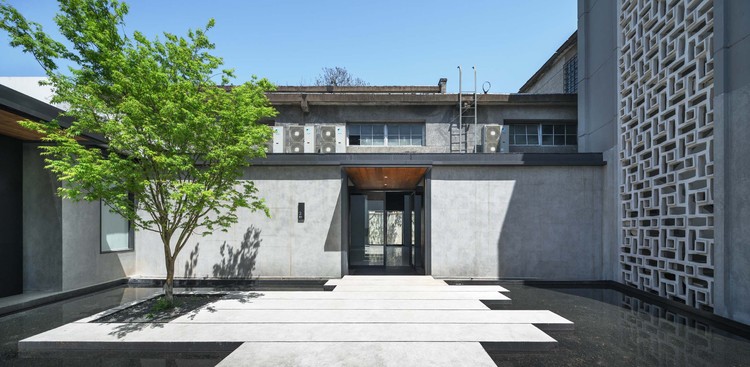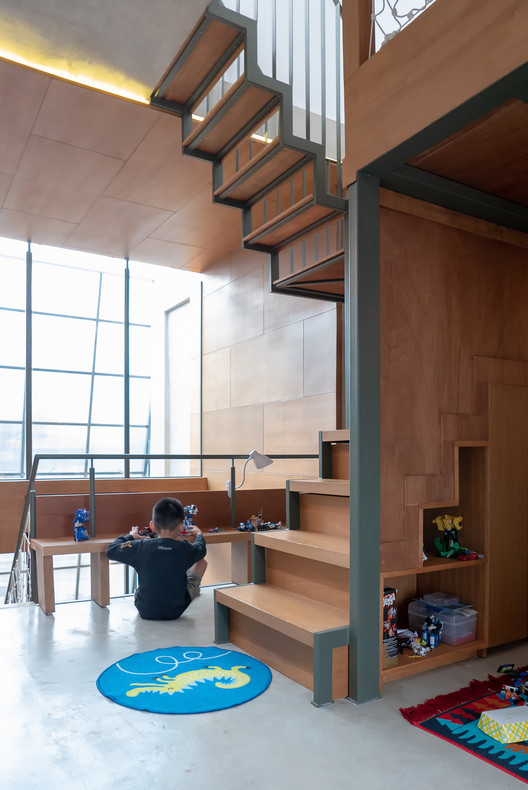Parish Church in Brácana Fresneda - Zamora Arquitectura
2018-05-10 05:00
架构师提供的文本描述。布拉卡纳一直想要自己的教堂。来自伊洛拉镇(西班牙格拉纳达)的这个地区的人,从天主教国王时代起就一直加入达维拉家族(后来算上瓜迪亚纳),他们总是在村里的寺庙外得到精神上的帮助,或者是因为他们来自附近的阿隆马尔特村等其他城市中心,或者是他们的私人性格,该镇唯一的宗教建筑:祖宗D.Luis Dávila Ponce de León(瓜迪亚纳第九伯爵)的特别演讲礼拜堂(1891年),由他的继承人于1940年修复。
Text description provided by the architects. Brácana always wanted its own church. The people from this district in Illora’s township (Granada, Spain), historically added since the Catholic Kings’s time to the Davila’s lineage (later Counts of Guadiana), were always spiritually assisted in outside temples of the village, either for their provenience to other urban centres like the nearby village of Alomartes, or their private character, case of the only religious building of the town: the particular oratory, then private chapel (1891) of the ancestral Lord D. Luis Dávila Ponce de León (IX count of Guadiana), restored by his heirs in 1940.
© Javier Callejas Sevilla
这种功用贷款,在某种程度上被认为是延续附庸关系或一度依赖的关系,是上世纪后半叶冲突的开始,当时,由于一种基于自身社会赋权的新情况,计票之间的关系变得越来越复杂和支离破碎。这个村庄在1960年代建造了自己的教堂,这是一个简单的教堂,用的资源不多,在随后的几年里,它开始出现稳定问题,该镇不得不返回“伯爵教堂”。自那时以来,与领主的冲突一再发生,使民众希望为村庄建立自己的教区,这体现了他们的宗教性、朴素和谦逊。因此,建立一个新教堂的想法变得重要,结束于2000年以来的临时情况。它开始了一个小城镇的令人兴奋的挑战,它深深扎根于自己的历史和宗教认同之中,寻求自治、自由和发展。
This functional loan, which in a certain way supposed to perpetuate the relationship of vassalage or once-dependence, was the beginning of conflicts in the second half of last century, when the relationships between the counts were more and more complicated and torn because of a new situation based of their own social empowerment. The village build his own church in the 1960’s, a simple church built by not many resources and during the following years it starts to have stability problems and the town has to return to the “Counts’ Chapel”. Since then, the conflicts with the lords have been recurring, causing in the population a wish of having their own parish for the village, representative of their religiousness, simplicity and humility. As a result, the idea of building a new church took on importance ending with the temporary situation since 2000. It started the exciting challenge of a little town that sinks its roots into its own history and religious identity, in search of autonomy, freedom and development.
© Javier Callejas Sevilla
前提是建立一个新的教堂,在那里的老教堂的村庄,遵循同样的原则:经济。它的设计与正确的尺寸,以容纳31个长椅,是使用在伯爵的礼拜堂。主弯道入口处优化入口处,使入口处达到大厅的功能,而不延长入口处的内凹。这是一个独特的覆盖空间,它被切割和拉伸在许多部分,限定空间到头部,并允许光线通过。这些部分包括洗手间,圣堂和小唱诗班以上,并提供良好的空气流通和热适应。
The premise is to build a new church where the old church of the village was, following the same principle: economy. It is designed with the right dimension to contain the 31 benches that are used in the Count’s chapel. The main bent entrance optimizes the entry area to do the function of hall, without extending the nave. This is a unique covered space that it is cut and stretched in many sections qualifying the space to the head and allowing light to pass through. These sections include the restroom areas, the sacristy and a little choir above and offer a good air circulation and thermal adaptation.
© Javier Callejas Sevilla
采用简单的双面钢框架,其变化和顺序解决了方案,提高了空间和塑性质量。简洁如必需品,如新鲜感,在这个项目中变成了一种愿望,而不会失去质量。
With a simple two sided steel frame, whose variations and sequencing resolve the program, the space and plastic quality is improved. The simplicity like a necessity, like newness, turns into an aspiration in this project without the loss of quality.
一种由喷射混凝土细层和刚性钢框架组成的单一结构溶液混合物,每隔120厘米设置在瓷砖陶瓷件外露模板上方,满足结构和围护的双重目的。每一种材料在建设性进程中都有其不可分割的作用,在进程结束时似乎是诚实和真诚的。在施工中,避免了模板、拱心和支撑辅助系统的使用。每一种材料都以教区居民与教区相联系的方式与建设性解决办法相联系。
A single constructive solution compound of a thin layer of sprayed concrete with rigid steel frames arranged each 120 centimetres, above an exposed formwork of tiled ceramic pieces to inwards, which meets the double purpose of structure and enclosure. Every material has its own inseparable function in the constructive progress and seems honest and sincere at the end of the process. In the construction it is avoided the use of auxiliary systems of formwork, arch centring and shoring. Each material is connected to the constructive solution in the same way as the parishioner is connected to the parish.
© Javier Callejas Sevilla
 举报
举报
别默默的看了,快登录帮我评论一下吧!:)
注册
登录
更多评论
相关文章
-

描边风设计中,最容易犯的8种问题分析
2018年走过了四分之一,LOGO设计趋势也清晰了LOGO设计
-

描边风设计中,最容易犯的8种问题分析
2018年走过了四分之一,LOGO设计趋势也清晰了LOGO设计
-

描边风设计中,最容易犯的8种问题分析
2018年走过了四分之一,LOGO设计趋势也清晰了LOGO设计







































































































